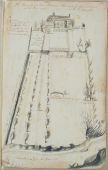John Bartram
[http://www.nga.gov/content/ngaweb/research/casva/research-projects.html A Project of the National Gallery of Art, Center for Advanced Study in the Visual Arts ]
Revision as of 21:36, November 13, 2014 by C-tompkins (talk | contribs) (Created page with "==Sites== ==Terms== Avenue, Column/Pillar, Clump, Eminence, Grove, Hothouse, Lake/Pond, Lawn, Meadow, Mound/Mount, Obelisk, Ora...")
Sites
Terms
Avenue, Column/Pillar, Clump, Eminence, Grove, Hothouse, Lake/Pond, Lawn, Meadow, Mound/Mount, Obelisk, Orangery, Pavilion, Picturesque, Plantation, Plot/Plat, Prospect, Shrubbery, Square, Terrace/Slope, View, Yard
Texts
- 18 July 1739, describing Westover, seat of William Byrd II, on the James River, Va. (1992: 121) [1]
- “Col Byrd is very prodigal in Gates roads walks hedges & seeders [cedars] trimed finely & A little green house with 2 or 3 [orange] trees . . .”
- 3 December 1762, describing Charleston, S.C. (quoted in Darlington 1849: 242–43) [2]
- “I can’t find, in our country, that south walls are much protection against our cold, for if we cover so close as to keep out the frost, they are suffocated.”
- Darlington, William, 1849, describing Bartram Botanic Garden and Nursery, vicinity of Philadelphia, Pa. (pp. 18–19) [3]
- “He [John Bartram] was, perhaps, the first Anglo-American who conceived the idea of establishing a BOTANIC GARDEN for the reception and cultivation of the various vegetables, natives of the country, as well as exotics, and of travelling for the discovery and acquisition of them.*
- “* The BARTRAM BOTANIC GARDEN, (established in or about the year 1730,) is most eligibly and beautifully situated, on the right bank of the river Schuylkill, a short distance below the city of Philadelphia. Being the oldest establishment of the kind in this western world, and exceedingly interesting, from its history and associations,—one might almost hope, even in this utilitarian age, that, if no motive more commendable could avail, a feeling of state or city pride, would be sufficient to ensure its preservation, in its original character, and for the sake of its original objects. But, alas! there seems to be too much reason to apprehend that it will scarcely survive the immediate family of its noble-hearted founder,—and that even the present generation may live to see the accumulated treasures of a century laid waste—with all the once gay parterres and lovely borders converted into lumberyards and coal-landings.”
Images
References
Notes
- ↑ Bartram, John. 1992. The Correspondence of John Bartram, 1734-1777. Edited by Edmund Berkeley and Dorothy Smith Berkeley. Gainesville: University Press of Florida. view on Zotero
- ↑ Darlington, William. 1849. Memorials of John Bartram and Humphry Marshall: With Notices of Their Botanical Contemporaries. Philadelphia: Lindsay & Blakiston. view on Zotero
- ↑ Darlington, William. 1849. Memorials of John Bartram and Humphry Marshall: With Notices of Their Botanical Contemporaries. Philadelphia: Lindsay & Blakiston. view on Zotero
